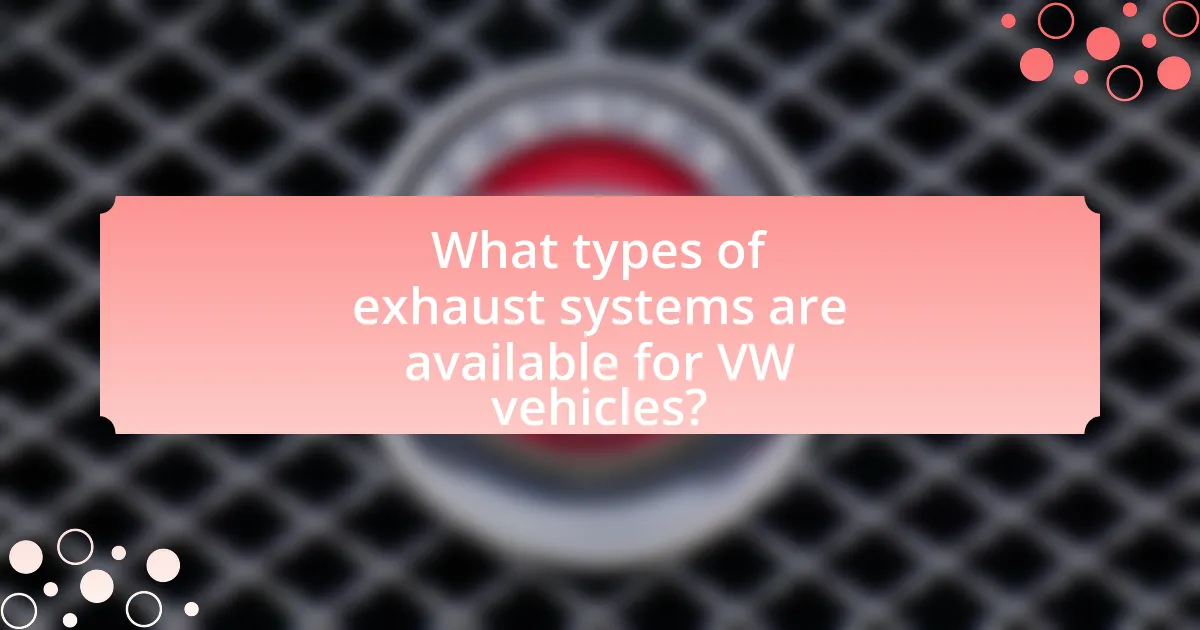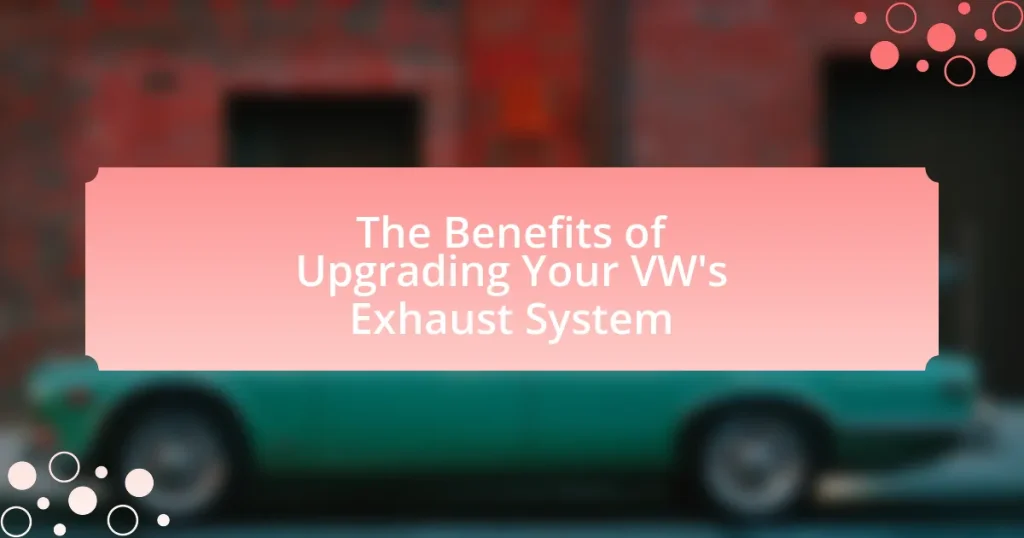Upgrading your VW’s exhaust system offers significant benefits, including enhanced performance, improved fuel efficiency, and a more appealing engine sound. A high-performance exhaust system reduces back pressure, allowing for better exhaust gas expulsion, which can lead to increased horsepower and torque. Additionally, aftermarket exhaust systems can improve fuel economy by optimizing engine efficiency and provide a more aggressive sound profile that many enthusiasts desire. The article explores the various types of exhaust systems available, the impact of material choices on performance and durability, and essential considerations for compliance with local regulations and maintenance practices.
What are the benefits of upgrading your VW’s exhaust system?
Upgrading your VW’s exhaust system enhances performance, improves fuel efficiency, and increases engine sound quality. A high-performance exhaust system reduces back pressure, allowing the engine to expel exhaust gases more efficiently, which can lead to a noticeable increase in horsepower and torque. Additionally, many aftermarket exhaust systems are designed to be lighter than stock systems, contributing to overall vehicle weight reduction and improved handling. Enhanced exhaust flow can also lead to better fuel economy, as the engine operates more efficiently. Furthermore, an upgraded exhaust system often provides a more aggressive and appealing sound, which many enthusiasts find desirable.
How does an upgraded exhaust system improve performance?
An upgraded exhaust system improves performance by enhancing the engine’s ability to expel exhaust gases more efficiently. This increased efficiency reduces back pressure, allowing the engine to breathe better and produce more power. Studies show that aftermarket exhaust systems can improve horsepower by 5-20%, depending on the vehicle and system design. Additionally, a less restrictive exhaust flow can lead to improved fuel efficiency, as the engine operates more effectively.
What specific performance gains can be expected from an upgraded exhaust?
An upgraded exhaust system can provide specific performance gains such as increased horsepower, improved torque, and enhanced throttle response. These gains occur because a high-performance exhaust reduces back pressure, allowing the engine to expel exhaust gases more efficiently. For instance, studies have shown that aftermarket exhaust systems can increase horsepower by 5-20% depending on the vehicle and the specific exhaust design. Additionally, improved airflow can lead to better fuel efficiency, as the engine operates more effectively.
How does exhaust flow affect engine efficiency?
Exhaust flow significantly affects engine efficiency by influencing the engine’s ability to expel combustion gases and intake fresh air. Improved exhaust flow reduces back pressure, allowing the engine to operate more efficiently, which can lead to increased horsepower and torque. Studies show that vehicles with optimized exhaust systems can experience efficiency gains of up to 10-15%, as enhanced flow dynamics facilitate better engine breathing. This is particularly relevant in performance vehicles, where every aspect of airflow contributes to overall power output and fuel economy.
What impact does an upgraded exhaust system have on sound?
An upgraded exhaust system significantly enhances the sound of a vehicle, typically resulting in a deeper, more aggressive tone. This improvement occurs due to changes in the exhaust flow dynamics, which reduce back pressure and allow for a more efficient expulsion of exhaust gases. Research indicates that aftermarket exhaust systems can increase sound volume by 10 to 30 decibels, depending on the design and materials used. Additionally, the use of performance mufflers and resonators in upgraded systems can further tailor the sound profile, providing a more pleasing auditory experience that many enthusiasts seek.
How can an upgraded exhaust enhance the driving experience through sound?
An upgraded exhaust enhances the driving experience through sound by producing a more aggressive and pleasing auditory profile. This improvement occurs because aftermarket exhaust systems are designed to optimize airflow, resulting in a deeper, more resonant tone that can evoke a sense of performance and excitement. Research indicates that a well-tuned exhaust can increase engine efficiency and power output, which often correlates with a more engaging sound. For example, studies show that vehicles equipped with performance exhaust systems can produce sound frequencies that enhance the emotional response of the driver, making the driving experience more enjoyable.
What are the different sound profiles available with aftermarket exhausts?
Aftermarket exhausts offer several distinct sound profiles, including aggressive, deep, and sporty tones. Aggressive sound profiles typically produce a loud, throaty roar that enhances the vehicle’s presence, often favored by performance enthusiasts. Deep sound profiles provide a rich, bass-heavy tone that resonates well at lower RPMs, creating a powerful auditory experience. Sporty sound profiles, on the other hand, deliver a higher-pitched, more refined sound that emphasizes the engine’s performance characteristics, appealing to those who prefer a balance between loudness and sophistication. These variations are achieved through different materials, muffler designs, and pipe configurations, allowing drivers to customize their vehicle’s auditory signature to match their personal preferences.
Why is upgrading your VW’s exhaust system beneficial for fuel efficiency?
Upgrading your VW’s exhaust system is beneficial for fuel efficiency because it enhances exhaust flow, reducing back pressure and allowing the engine to operate more efficiently. Improved exhaust flow leads to better combustion, which can increase horsepower and torque while optimizing fuel consumption. Studies have shown that vehicles with upgraded exhaust systems can achieve fuel economy improvements of up to 10% or more, depending on the specific modifications and driving conditions. This efficiency gain is primarily due to the engine working less hard to expel exhaust gases, resulting in lower fuel usage for the same power output.
How does exhaust system design influence fuel consumption?
Exhaust system design significantly influences fuel consumption by affecting engine efficiency and back pressure. A well-designed exhaust system minimizes back pressure, allowing exhaust gases to exit the engine more freely, which enhances engine performance and fuel efficiency. For instance, studies have shown that vehicles with optimized exhaust systems can achieve up to a 10% improvement in fuel economy due to reduced engine load and better airflow dynamics. Additionally, the use of high-performance materials and larger diameter pipes in exhaust systems can further decrease resistance, leading to more efficient combustion and lower fuel consumption.
What role does back pressure play in fuel efficiency?
Back pressure significantly affects fuel efficiency by influencing the engine’s ability to expel exhaust gases. When back pressure is too high, it can restrict exhaust flow, leading to reduced engine performance and increased fuel consumption. Conversely, optimal back pressure allows for efficient exhaust evacuation, enhancing engine efficiency and power output. Studies indicate that engines designed with proper exhaust systems can improve fuel efficiency by up to 10% due to reduced back pressure, allowing for better combustion and energy utilization.

What types of exhaust systems are available for VW vehicles?
VW vehicles have several types of exhaust systems available, including cat-back exhaust systems, axle-back exhaust systems, header systems, and performance exhaust systems. Cat-back exhaust systems replace the exhaust components from the catalytic converter back, enhancing performance and sound. Axle-back systems replace the exhaust components from the rear axle back, primarily focusing on sound improvement. Header systems replace the factory exhaust manifolds, optimizing exhaust flow for better performance. Performance exhaust systems are designed for increased horsepower and torque, often featuring high-flow catalytic converters and mandrel-bent tubing. These options cater to various performance needs and sound preferences among VW enthusiasts.
What are the differences between cat-back and axle-back exhaust systems?
Cat-back and axle-back exhaust systems differ primarily in their installation location and the components they replace. A cat-back exhaust system replaces everything from the catalytic converter to the exhaust tip, enhancing overall exhaust flow and potentially improving performance and sound. In contrast, an axle-back exhaust system only replaces the components located behind the rear axle, typically focusing on sound enhancement without significantly altering exhaust flow. This distinction is crucial for vehicle performance upgrades, as cat-back systems generally provide more substantial gains in horsepower and torque due to their comprehensive design.
What are the advantages of choosing a cat-back exhaust system?
Choosing a cat-back exhaust system offers several advantages, including improved performance, enhanced sound, and increased durability. The improved performance results from better exhaust flow, which can lead to increased horsepower and torque, as supported by various automotive studies showing that aftermarket exhaust systems can enhance engine efficiency. The enhanced sound provides a sportier and more aggressive tone, appealing to enthusiasts who seek a more engaging driving experience. Additionally, cat-back systems are typically constructed from high-quality materials, such as stainless steel, which increases their longevity and resistance to corrosion compared to factory exhausts.
In what scenarios would an axle-back exhaust be more suitable?
An axle-back exhaust is more suitable in scenarios where a vehicle owner seeks to enhance sound and aesthetics without significantly altering performance or requiring extensive modifications. This type of exhaust system primarily replaces the muffler and tailpipe sections, allowing for a more aggressive exhaust note while maintaining the factory headers and mid-pipes. Additionally, axle-back exhausts are ideal for those who want a straightforward installation process, as they typically require minimal tools and expertise, making them accessible for DIY enthusiasts. Furthermore, they are often chosen by individuals looking to comply with local noise regulations while still achieving a sportier sound profile.
How do different materials affect the performance of exhaust systems?
Different materials significantly affect the performance of exhaust systems by influencing factors such as weight, durability, heat resistance, and sound attenuation. For instance, stainless steel is commonly used due to its corrosion resistance and ability to withstand high temperatures, which enhances the longevity and efficiency of the exhaust system. In contrast, mild steel is less expensive but more prone to rust, leading to reduced performance over time. Additionally, titanium, while lightweight and highly durable, offers superior heat dissipation, which can improve exhaust flow and overall engine performance. Research indicates that exhaust systems made from high-quality materials can lead to a measurable increase in horsepower and torque, demonstrating the importance of material choice in optimizing vehicle performance.
What are the benefits of stainless steel versus aluminized steel?
Stainless steel offers superior corrosion resistance compared to aluminized steel, making it a more durable choice for exhaust systems. This corrosion resistance is due to the presence of chromium, which forms a protective oxide layer that prevents rust and degradation. In contrast, aluminized steel, while initially resistant to corrosion, can deteriorate over time, especially in high-temperature environments or when exposed to moisture. Additionally, stainless steel has a higher tensile strength, allowing it to withstand higher temperatures and pressures without deforming, which is crucial for performance in automotive applications. This combination of durability and strength makes stainless steel a preferred material for upgrading exhaust systems in vehicles like VW.
How does the choice of material impact durability and sound?
The choice of material significantly impacts both durability and sound in exhaust systems. Stainless steel, for example, offers high resistance to corrosion and heat, leading to a longer lifespan compared to mild steel, which can rust and degrade quickly. Additionally, the material affects sound quality; stainless steel tends to produce a sharper, more aggressive tone, while mild steel may result in a duller sound. Research indicates that exhaust systems made from high-grade stainless steel can last over 10 years, while those made from lower-quality materials may fail within 3 to 5 years, demonstrating the importance of material selection for both durability and sound performance.
What considerations should be made before upgrading your VW’s exhaust system?
Before upgrading your VW’s exhaust system, you should consider compatibility with your vehicle’s make and model. Ensuring that the new exhaust system fits properly is crucial, as mismatched components can lead to performance issues or damage. Additionally, evaluate the intended purpose of the upgrade, whether for improved performance, sound enhancement, or aesthetic appeal, as this will influence the type of exhaust system you choose. It’s also important to consider local emissions regulations, as some aftermarket exhaust systems may not comply with legal standards, potentially resulting in fines or failed inspections. Lastly, assess your budget, as high-quality exhaust systems can vary significantly in price, and installation costs should also be factored in.
How do local regulations affect exhaust system modifications?
Local regulations significantly impact exhaust system modifications by establishing legal standards for emissions, noise levels, and safety. These regulations vary by jurisdiction, often requiring compliance with specific emissions testing and noise ordinances. For instance, in California, the California Air Resources Board enforces strict emissions standards that prohibit modifications that increase emissions beyond factory levels. Failure to adhere to these regulations can result in fines, vehicle impoundment, or the inability to pass state inspections, thereby affecting the legality and functionality of modified exhaust systems.
What emissions standards must be adhered to when upgrading?
When upgrading a vehicle’s exhaust system, it is essential to adhere to the emissions standards set by the Environmental Protection Agency (EPA) and, where applicable, state regulations. These standards include compliance with the Clean Air Act, which mandates that vehicles must not exceed specific emissions limits for pollutants such as nitrogen oxides (NOx), carbon monoxide (CO), and particulate matter (PM). Additionally, upgrades must ensure that the vehicle remains compliant with any applicable state-specific emissions regulations, which can vary significantly. For example, California has its own stringent emissions standards under the California Air Resources Board (CARB), which often require aftermarket parts to be CARB-certified. Compliance with these standards is crucial to avoid penalties and ensure the vehicle remains roadworthy.
How can you ensure compliance with noise regulations?
To ensure compliance with noise regulations, you should install an exhaust system that meets the specific decibel limits set by local laws. Many regions have established maximum noise levels for vehicles, often around 95 decibels for passenger cars. Upgrading to a certified exhaust system designed to reduce noise can help achieve this compliance. Additionally, regular maintenance and inspections of the exhaust system can prevent excessive noise due to wear or damage, ensuring that the vehicle remains within legal limits.
What should you look for when selecting an aftermarket exhaust system?
When selecting an aftermarket exhaust system, prioritize compatibility with your vehicle’s make and model to ensure proper fitment and performance. Additionally, consider the material quality, as stainless steel offers durability and resistance to corrosion, while mild steel may be less expensive but prone to rust. Evaluate the exhaust design, such as cat-back or axle-back systems, which can influence sound and performance. Furthermore, check for performance gains, as reputable brands often provide dyno results to demonstrate improvements in horsepower and torque. Lastly, review customer feedback and expert reviews to gauge reliability and satisfaction, ensuring you choose a system that meets your performance and aesthetic preferences.
How do brand reputation and reviews influence your choice?
Brand reputation and reviews significantly influence consumer choice by shaping perceptions of quality and reliability. A strong brand reputation often correlates with positive reviews, which can lead to increased trust and confidence in purchasing decisions. For instance, studies show that 84% of people trust online reviews as much as personal recommendations, indicating that favorable reviews can sway potential buyers towards a brand. Additionally, brands with high ratings and positive feedback tend to attract more customers, as consumers often associate good reviews with superior product performance and customer satisfaction.
What features should be prioritized for optimal performance?
For optimal performance in upgrading a VW’s exhaust system, features such as increased exhaust flow, reduced back pressure, and improved material quality should be prioritized. Increased exhaust flow enhances engine efficiency by allowing gases to exit more freely, which can lead to better horsepower and torque. Reduced back pressure minimizes the resistance against the engine’s exhaust gases, promoting quicker turbo spool times and overall responsiveness. High-quality materials, such as stainless steel, ensure durability and resistance to corrosion, which contributes to long-term performance and reliability. These features collectively enhance the vehicle’s performance metrics, making them essential considerations in exhaust system upgrades.
What are some tips for maintaining your upgraded exhaust system?
To maintain your upgraded exhaust system, regularly inspect for leaks, corrosion, and loose connections. Checking for leaks ensures optimal performance and prevents exhaust gases from entering the cabin, while addressing corrosion can extend the lifespan of the system. Additionally, tightening any loose connections helps maintain proper exhaust flow and reduces noise. Regular cleaning of the exhaust tips prevents buildup that can affect appearance and performance. Following these maintenance tips can enhance the efficiency and longevity of your upgraded exhaust system.
How can regular inspections prolong the life of your exhaust system?
Regular inspections can prolong the life of your exhaust system by identifying and addressing issues such as corrosion, leaks, and blockages before they escalate into more significant problems. These inspections allow for timely maintenance, which can prevent the deterioration of components and ensure optimal performance. For instance, a study by the Automotive Service Association indicates that regular maintenance can extend the lifespan of exhaust systems by up to 50%. By catching minor issues early, vehicle owners can avoid costly repairs and replacements, ultimately enhancing the durability and efficiency of the exhaust system.
What common issues should you watch for after installation?
After installation of a new exhaust system in a VW, common issues to watch for include exhaust leaks, improper fitment, and unusual noises. Exhaust leaks can occur at connection points, leading to decreased performance and potential damage to engine components. Improper fitment may result in the exhaust system hanging too low or misaligned, causing contact with other parts of the vehicle. Unusual noises, such as rattling or excessive loudness, can indicate loose components or a malfunctioning system. Monitoring these issues ensures optimal performance and longevity of the upgraded exhaust system.


